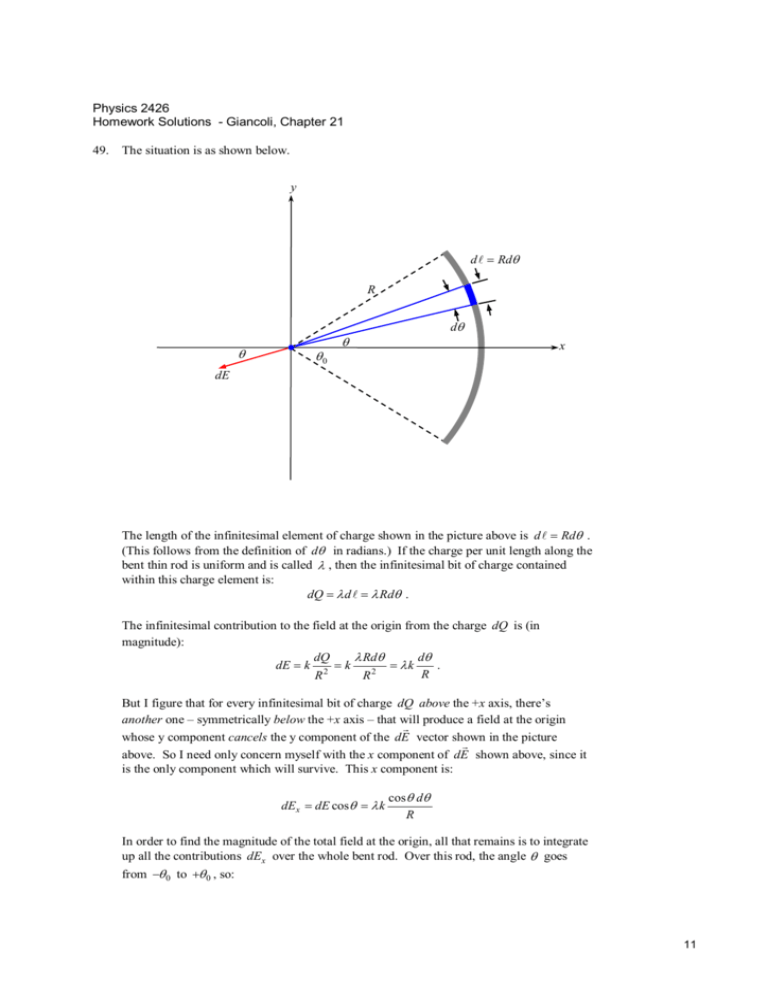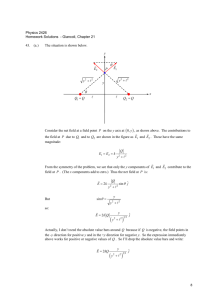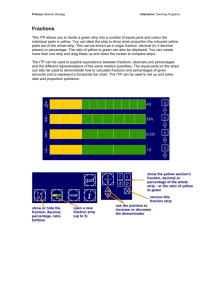Homework Solutions - Giancoli, Chapter 21 49. The situation is as
advertisement

Physics 2426 Homework Solutions - Giancoli, Chapter 21 49. The situation is as shown below. y d = Rdθ R θ θ0 dθ θ x dE The length of the infinitesimal element of charge shown in the picture above is d = Rdθ . (This follows from the definition of dθ in radians.) If the charge per unit length along the bent thin rod is uniform and is called λ , then the infinitesimal bit of charge contained within this charge element is: dQ = λ d = λ Rdθ . The infinitesimal contribution to the field at the origin from the charge dQ is (in magnitude): dQ λ Rdθ dθ dE = k 2 = k = λk . R R R2 But I figure that for every infinitesimal bit of charge dQ above the +x axis, there’s another one – symmetrically below the +x axis – that will produce a field at the origin whose y component cancels the y component of the dE vector shown in the picture above. So I need only concern myself with the x component of dE shown above, since it is the only component which will survive. This x component is: dEx = dE cosθ = λ k cosθ dθ R In order to find the magnitude of the total field at the origin, all that remains is to integrate up all the contributions dEx over the whole bent rod. Over this rod, the angle θ goes from −θ 0 to +θ 0 , so: 11 Physics 2426 Homework Solutions - Giancoli, Chapter 21 E x = dE x = λk R +θ0 cos θ dθ , −θ 0 in which I’ve recognized that the factor 1 R is constant all along the rod, so it comes outside the integral. Doing the integration, I get: E= λk R sin θ 0 − sin ( −θ0 ) = 2λ k sin θ0 . R As a vector in component form: E=− 2λ k sin θ 0 ˆ i, R where the minus sign must be included because E points to the left when λ is positive. 53. The result of Example 21-10 says that the E-field a distance r away from an infinite line charge is: E= 1 λ 2πε 0 r . In the limit as L → ∞ , then, we can think of the infinite sheet of charge shown in Figure 21-58 as being made up of a bunch of infinite line charges, each producing a field of magnitude given by the expression immediately above. Let us imagine the strip of width dy shown in Figure 21-58 to extend from x = −∞ to x = +∞ . Then the magnitude of the infinitesimal contribution to the field at P that this strip produces is: dE = 1 2πε 0 λ y2 + z2 , in which I’ve recognized that the distance from this strip to the point P is y 2 + z 2 . (See Figure 21-58.) Now, λ is supposed to represent the charge per unit length along this strip, but how do we write this in terms of σ , the charge per unit area on the sheet? Well, the answer is: λ = σ dy . (That is, the charge per unit length along this strip is the charge per unit area times the width of the strip.) So the contribution to the field at P due to this strip becomes: dE = 1 2πε 0 σ dy y2 + z2 . However, once again I need to think about the symmetry of the charge distribution. For every strip at some positive value of y that produces a field dE having a negative dE y , as shown in Figure 21-58, there will be another such strip – at a negative value of y – that will produce a field dE having a positive dE y that cancels the y component from the first strip. Therefore, only the z components of the field will survive, and it is only these components that I need to integrate up. As shown in Figure 21-58, the z component of the field produced by a given strip is related to the overall magnitude dE of the field produced by this strip by the equation: 12









